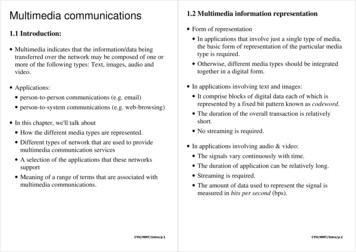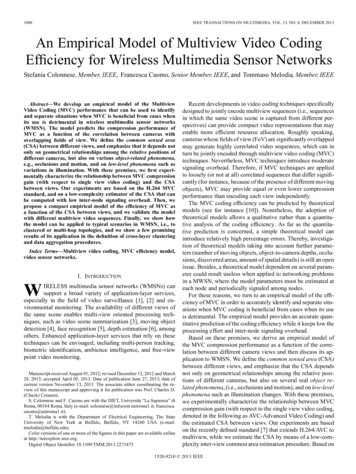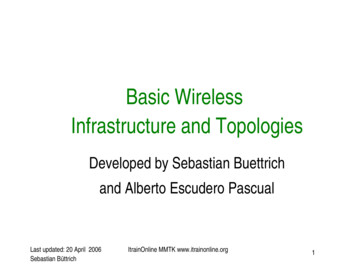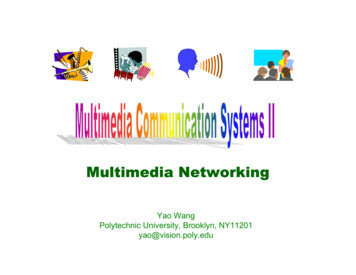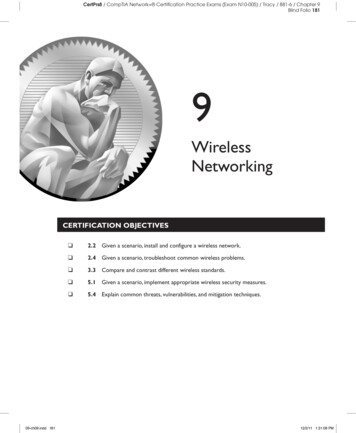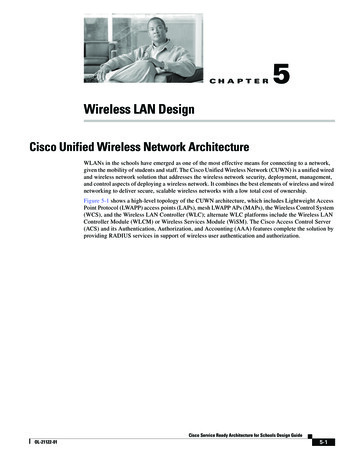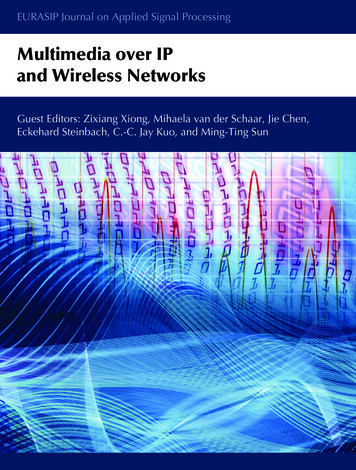
Transcription
EURASIP Journal on Applied Signal ProcessingMultimedia over IPand Wireless NetworksGuest Editors: Zixiang Xiong, Mihaela van der Schaar, Jie Chen,Eckehard Steinbach, C.-C. Jay Kuo, and Ming-Ting Sun
EURASIP Journal on Applied Signal ProcessingMultimedia over IP and Wireless Networks
EURASIP Journal on Applied Signal ProcessingMultimedia over IP and Wireless NetworksGuest Editors: Zixiang Xiong, Mihaela van der Schaar,Jie Chen, Eckehard Steinbach, C.-C. Jay Kuo,and Ming-Ting Sun
Copyright 2004 Hindawi Publishing Corporation. All rights reserved.This is a special issue published in volume 2004 of “EURASIP Journal on Applied Signal Processing.” All articles are open accessarticles distributed under the Creative Commons Attribution License, which permits unrestricted use, distribution, and reproductionin any medium, provided the original work is properly cited.
Editor-in-ChiefMarc Moonen, BelgiumSenior Advisory EditorK. J. Ray Liu, College Park, USAAssociate EditorsKiyoharu Aizawa, JapanGonzalo Arce, USAJaakko Astola, FinlandKenneth Barner, USAMauro Barni, ItalySankar Basu, USAJacob Benesty, CanadaHelmut Bölcskei, SwitzerlandChong-Yung Chi, TaiwanM. Reha Civanlar, TurkeyTony Constantinides, UKLuciano Costa, BrazilSatya Dharanipragada, USAPetar M. Djurić, USAJean-Luc Dugelay, FranceTouradj Ebrahimi, SwitzerlandSadaoki Furui, JapanMoncef Gabbouj, FinlandSharon Gannot, IsraelFulvio Gini, ItalyA. Gorokhov, The NetherlandsPeter Handel, SwedenUlrich Heute, GermanyJohn Homer, AustraliaJiri Jan, CzechSøren Holdt Jensen, DenmarkMark Kahrs, USAThomas Kaiser, GermanyMoon Gi Kang, KoreaAggelos Katsaggelos, USAMos Kaveh, USAC.-C. Jay Kuo, USAChin-Hui Lee, USAKyoung Mu Lee, KoreaSang Uk Lee, KoreaY. Geoffrey Li, USAMark Liao, TaiwanBernie Mulgrew, UKKing N. Ngan, Hong KongDouglas O’Shaughnessy, CanadaAntonio Ortega, USAMontse Pardas, SpainIoannis Pitas, GreecePhillip Regalia, FranceMarkus Rupp, AustriaHideaki Sakai, JapanBill Sandham, UKWan-Chi Siu, Hong KongDirk Slock, FrancePiet Sommen, The NetherlandsJohn Sorensen, DenmarkMichael G. Strintzis, GreeceSergios Theodoridis, GreeceJacques Verly, BelgiumXiaodong Wang, USADouglas Williams, USAAn-Yen (Andy) Wu, TaiwanXiang-Gen Xia, USA
ContentsEditorial, Zixiang Xiong, Mihaela van der Schaar, Jie Chen, Eckehard Steinbach, C.-C. Jay Kuo,and Ming-Ting SunVolume 2004 (2004), Issue 2, Pages 155-157Source and Channel Adaptive Rate Control for Multicast Layered Video Transmission Based ona Clustering Algorithm, Jérôme Viéron, Thierry Turletti, Kavé Salamatian, and Christine GuillemotVolume 2004 (2004), Issue 2, Pages 158-175Fine-Grained Rate Shaping for Video Streaming over Wireless Networks, Trista Pei-chun Chenand Tsuhan ChenVolume 2004 (2004), Issue 2, Pages 176-191SMART: An Efficient, Scalable, and Robust Streaming Video System, Feng Wu, Honghui Sun,Guobin Shen, Shipeng Li, Ya-Qin Zhang, Bruce Lin, and Ming-Chieh LeeVolume 2004 (2004), Issue 2, Pages 192-206Optimal Erasure Protection Assignment for Scalable Compressed Data with Small Channel Packetsand Short Channel Codewords, Johnson Thie and David TaubmanVolume 2004 (2004), Issue 2, Pages 207-219Performance and Complexity Co-evaluation of the Advanced Video Coding Standard forCost-Effective Multimedia Communications, Sergio Saponara, Kristof Denolf, Gauthier Lafruit,Carolina Blanch, and Jan BormansVolume 2004 (2004), Issue 2, Pages 220-235New Complexity Scalable MPEG Encoding Techniques for Mobile Applications, Stephan Mietens,Peter H. N. de With, and Christian HentschelVolume 2004 (2004), Issue 2, Pages 236-252Interactive Video Coding and Transmission over Heterogeneous Wired-to-Wireless IP NetworksUsing an Edge Proxy, Yong Pei and James W. ModestinoVolume 2004 (2004), Issue 2, Pages 253-264Scalable Video Transcaling for the Wireless Internet, Hayder Radha, Mihaela van der Schaar,and Shirish KarandeVolume 2004 (2004), Issue 2, Pages 265-279Effective Quality-of-Service Renegotiating Schemes for Streaming Video, Hwangjun Songand Dai-Boong LeeVolume 2004 (2004), Issue 2, Pages 280-289Error Resilient Video Compression Using Behavior Models, Jacco R. Taal, Zhibo Chen, Yun He,and R. (Inald) L. LagendijkVolume 2004 (2004), Issue 2, Pages 290-303An Integrated Source and Channel Rate Allocation Scheme for Robust Video Coding andTransmission over Wireless Channels, Jie Song and K. J. Ray LiuVolume 2004 (2004), Issue 2, Pages 304-316
Medusa: A Novel Stream-Scheduling Scheme for Parallel Video Servers, Hai Jin, Dafu Deng,and Liping PangVolume 2004 (2004), Issue 2, Pages 317-329
EURASIP Journal on Applied Signal Processing 2004:2, 155–157c 2004 Hindawi Publishing Corporation EditorialZixiang XiongDepartment of Electrical Engineering, Texas A&M University, College Station, TX 77843, USAEmail: zx@ee.tamu.eduMihaela van der SchaarDepartment of Electrical and Computer Engineering, University of California, Davis, CA 95616-5294, USAEmail: mvanderschaar@ece.ucdavis.eduJie ChenDivision of Engineering, Brown University, Providence, RI 02912-9104, USAEmail: jie chen@brown.eduEckehard SteinbachInstitute of Communication Networks, Munich University of Technology, 80290 Munich, GermanyEmail: eckehard.steinbach@tum.deC.-C. Jay KuoSignal and Image Processing Institute, University of Southern California, Los Angeles, CA 90089, USAEmail: cckuo@sipi.usc.eduMing-Ting SunDepartment of Electrical Engineering, University of Washington, Seattle, WA 98195-2500, USAEmail: sun@ee.washigton.eduMultimedia—an integrated and interactive presentation ofspeech, audio, video, graphics, and text—has become a major driving force behind a multitude of applications. Increasingly, multimedia content is being accessed by a large number of diverse users and clients at anytime, and from anywhere, across various communication channels such as theInternet and wireless networks. As mobile cellular and wireless LAN networks are evolving to carry multimedia data,an all-IP-based system akin to the Internet is likely to beemployed due to its cost efficiency, improved reliability, allowance of easy implementation of new services, independence of control and transport, and importantly, easy integration of multiple networks.However, reliable transmission of multimedia over suchan integrated IP-based network poses many challenges. Thisis not just due to the inherently lower transmission rates provided by these networks as compared with traditional delivery networks (e.g., ATM, cable networks, satellite), but alsodue to associated problems such as congestion, competingtraffic, fading, interference, and mobility, all of which lead tovarying transmission capacity and losses.Consequently, to achieve a high level of acceptability andproliferation of networked multimedia, a solution for reliableand efficient transmission over IP and wireless networks isrequired. Several key requirements need to be satisfied.(1) Easy adaptability to rate variations since the availabletransmission capacity may vary due to interference,overlapping wireless LANs, competing traffic, mobility, multipath fading, and so forth.(2) Robustness to data losses since depending on the channel condition, partial data losses may occur.(3) Support for device scalability and user preferences sincevarious clients may be connected at different data ratesand request transmissions that are optimized for theirrespective connections and capabilities.(4) Limited complexity implementations for mobile wireless devices.
156(5) Adaptation to the quality-of-service (QoS) provided bythe network.(6) Efficient end-to-end transmission over different networks exhibiting various characteristics and QoS guarantees.To address the above-mentioned requirements, innovativesolutions are needed for adaptive and error-resilient multimedia compression, error control, error protection andconcealment, multimedia streaming architectures, channelmodels and channel estimation, packetization and scheduling, and so forth. Such solutions can best be developed by acombination of theory, tools, and methods from the fieldsof networking, signal processing, and computer engineering. This integrated and cross-disciplinary approach has ledto the advent of a new research wave in compression, jointsource-channel coding, and network-adaptive media delivery, and has motivated the emergence of novel compressionstandards, transmission protocols, and networking solutions.Recently, both the academic and industrial communities have realized the potential of such integrated solutionsfor multimedia applications. Consequently, multimedia networking is evolving as one of the most active research areas.Despite the significant research efforts in this area, numerous problems related to the optimal design of source codingschemes aimed at transmission over a variety of networks,joint source-channel coding trade-offs, and flexible multimedia architectures remain open.This special issue is an attempt to cover a wide range oftopics under the broad multimedia networking umbrella bypublishing twelve papers reporting on recent results in theabove-mentioned research areas. The papers in this specialissue correspond to advances in five different areas of multimedia networking:(i) layered coding and transmission,(ii) cost-effective and complexity-scalable implementations,(iii) efficient end-to-end transmission using proxies,(iv) quality of service,(v) mechanisms for robust coding and transmission.In the first area, Viéron et al., T. P.-C. Chen and T. Chen,Wu et al., and Thie and Taubman dedicate four papers, respectively, to robust video transmission using layered coding,covering various aspects such as joint source-channel coding, rate-shaping, and efficient streaming strategies. In thesecond area, Saponara et al. and Mietens et al. consider costeffective and complexity-scalable implementations of the different video compression standards employed for multimedia communication applications. In the third area, Pei andModestino, and Radha et al. consider the use of proxies forimproving the video quality when transmitted over multiplehop wireless or wired networks exhibiting different channelcharacteristics. In the fourth area, Song and Lee consider theeffective mechanisms for QoS using renegotiating schemesfor streaming video. In the fifth area, Taal et al., Song andLiu, and Jin et al. consider different mechanisms for robustvideo coding and transmission, such as source-channel rateEURASIP Journal on Applied Signal Processingallocation schemes, novel scheduling strategies for video distribution using parallel servers, and optimization of errorresilient video transmission using behavior models.As this special issue illustrates, academic and industrialresearch in multimedia networking is becoming increasinglyvibrant, and the field continues to pose new challenges thatwill require innovative approaches. Potential solutions willneed to cross the boundaries between the fields of signal processing, networking, and computer engineering, and we believe that such cross-fertilization is likely to catalyze many interesting and relevant new research topics and applications.Zixiang XiongMihaela van der SchaarJie ChenEckehard SteinbachC.-C. Jay KuoMing-Ting SunZixiang Xiong received his Ph.D. degree inelectrical engineering in 1996 from the University of Illinois at Urbana-Champaign.From 1997 to 1999, he was with the University of Hawaii. Since 1999, he has been withthe Department of Electrical Engineering atTexas A&M University, where he is an Associate Professor. He spent the summers of1998 and 1999 at Microsoft Research, Redmond, Wash and the summers of 2000 and2001 at Microsoft Research in Beijing. His current research interests are distributed source coding, joint source-channel coding, andgenomic signal processing. Dr. Xiong received a National ScienceFoundation (NSF) Career Award in 1999, an Army Research Office(ARO) Young Investigator Award in 2000, and an Office of NavalResearch (ONR) Young Investigator Award in 2001. He also received Faculty Fellow Awards in 2001, 2002, and 2003 from TexasA&M University. He is currently an Associate Editor for the IEEETransactions on Circuits and Systems for Video Technology, theIEEE Transactions on Signal Processing, and the IEEE Transactionson Image Processing.Mihaela van der Schaar is currently an Assistant Professor in the Electrical and Computer Engineering Department at the University of California, Davis. She receivedher Ph.D. degree in electrical engineeringfrom Eindhoven University of Technology,the Netherlands. Between 1996 and June2003, she was a Senior Member ResearchStaff at Philips Research in the Netherlandsand USA. In 1998, she worked in the Wireless Communications and Networking Department. From Januaryto September 2003, she was also an Adjunct Assistant Professor atColumbia University. In 1999, she become an active participant tothe MPEG-4 standard, contributing to the scalable video codingactivities. She is currently chairing the MPEG Ad-hoc group onScalable Video Coding, and is also cochairing the Ad-hoc groupon Multimedia Test Bed. Her research interests include multimedia coding, processing, networking, and architectures. She has authored more than 70 book chapters, and conference and journal
Editorialpapers and holds 9 patents and several more pending. She was alsoelected as a member of the Technical Committee on MultimediaSignal Processing of the IEEE Signal Processing Society and is anAssociate Editor of IEEE Transactions on Multimedia and an Associate Editor of Optical Engineering.Jie Chen received his M.S. and Ph.D. degrees in electrical engineering from the University of Maryland, College Park. He is currently an Assistant Professor at Brown University in the Division of Engineering, andthe head of Brown BINARY lab. From 2000to 2002, he has worked as a Principal SystemEngineer of two startup companies, first Lucent Digital Radio, then cofounded FlarionTechnology. Dr. Chen’s research interests include multimedia communication, nano-scale device modeling,and genomic signal processing. He has received NSF Award, Division Award from Bell Labs, and Student Paper Award. He has beeninvited as the speaker in different conferences and workshops. Since1997, Dr. Chen has authored or coauthored 46 scientific papers inrefereed journals and conference proceedings—35 as the first author. He first-authored the book Design of Digital Video Coding Systems: A Complete Compressed Domain Approach (New York: MarcelDekker 2001); and coedited another textbook, Genomic Signal Processing and Statistics (EURASIP Book Series, 2004). He has inventedor coinvented seven US patents. Currently, he is the Associate Editor of IEEE Signal Processing Magazine, IEEE Transactions on Multimedia, and EURASIP Journal on Applied Signal Processing.Eckehard Steinbach studied electrical engineering at the University of Karlsruhe, Germany, the University of Essex, UK, and ESIEE in Paris. From 1994 to 2000, he was amember of the research staff of the ImageCommunication Group at the University ofErlangen-Nuremberg, Germany, where hereceived the Engineering Doctorate in 1999.From February 2000 to December 2001, hewas a Postdoctoral Fellow at the Information Systems Laboratory, Stanford University. In February 2002, hejoined the Department of Electrical Engineering and InformationTechnology, Technische Universität München, Germany, where heis currently an Associate Professor of media technology. Dr. Steinbach served as a Conference Cochair of SPIE Visual Communications and Image Processing (VCIP ’01) in San Jose, California, in2001. He also served as a Conference Cochair of Vision, Modeling,and Visualization (VMV ’03) held in Munich in November 2003.His current research interests are in the area of networked multimedia systems.C.-C. Jay Kuo received his B.S. degree fromthe National Taiwan University, Taipei, in1980 and the M.S. and Ph.D. degrees fromthe Massachusetts Institute of Technology,Cambridge, in 1985 and 1987, respectively,all in electrical engineering. Since January1989, he has been with the Department ofElectrical Engineering Systems at the University of Southern California. His researchinterests are in the areas of digital signal andimage processing, audio and video coding, multimedia communication technologies and delivery protocols, and embedded systemdesign. Kuo is a Fellow of IEEE and SPIE and a Member of ACM.157He is Editor-in-Chief of the Journal of Visual Communication andImage Representation, Associate Editor of IEEE Transactions onSpeech and Audio Processing, and Editor of the EURASIP Journal on Applied Signal Processing. He is also in the Editorial Boardof the IEEE Signal Processing Magazine. He received the NationalScience Foundation Young Investigator Award (NYI) and Presidential Faculty Fellow (PFF) Award in 1992 and 1993, respectively. Hehas guided about 52 students to their Ph.D. degrees and supervised9 Postdoctoral Research Fellows. He is a coauthor of six books andmore than 600 technical publications in international conferencesand journals.Ming-Ting Sun received the B.S. degreefrom National Taiwan University in 1976,the M.S. degree from University of Texasat Arlington in 1981, and the Ph.D. degreefrom University of California, Los Angelesin 1985, all in electrical engineering. Dr. Sunjoined the University of Washington in August 1996 where he is now a Professor. Hisresearch interests include video coding andnetworking, multimedia technologies, andVLSI for signal processing. Dr. Sun has been awarded 8 patents andhas published more than 140 technical papers in journals and conferences. He has authored or coauthored 10 book chapters in thearea of video technology, and has coedited a book on compressedvideo over networks. He has served in various leadership positionsincluding the Chair of the IEEE CAS Standards Committee, theEditor-in-Chief of IEEE Transactions on Circuits and Systems forVideo Technology (TCSVT), General Cochair of Visual Communication and Image Processing, and the Editor-in-Chief of IEEETransactions on Multimedia. Dr. Sun has received many awardsincluding the Award of Excellence from Bellcore, the TCSVT BestPaper Award, and the Golden Jubilee Medal from the IEEE CASSociety. Dr. Sun is a Fellow of IEEE.
EURASIP Journal on Applied Signal Processing 2004:2, 158–175c 2004 Hindawi Publishing Corporation Source and Channel Adaptive Rate Controlfor Multicast Layered Video TransmissionBased on a Clustering AlgorithmJérôme ViéronThomson multimedia R&D, 1 avenue Bellefontaine - CS 17616, 35576 Cesson-Sévigné, FranceEmail: jerome.vieron@inria.frThierry TurlettiINRIA, 2004 route des Lucioles - BP 93, 06902 Sophia Antipolis Cedex, FranceEmail: thierry.turletti@inria.frKavé SalamatianLaboratoire d’Informatique de Paris 6 (LIP6), 8 rue du Capitaine Scott, 75015 Paris, FranceEmail: kave.salamatian@inria.frChristine GuillemotINRIA, Campus de Beaulieu, 35042 Rennes Cedex, FranceEmail: christine.guillemot@inria.frReceived 24 October 2002; Revised 8 July 2003This paper introduces source-channel adaptive rate control (SARC), a new congestion control algorithm for layered video transmission in large multicast groups. In order to solve the well-known feedback implosion problem in large multicast groups, wefirst present a mechanism for filtering RTCP receiver reports sent from receivers to the whole session. The proposed filteringmechanism provides a classification of receivers according to a predefined similarity measure. An end-to-end source and FEC ratecontrol based on this distributed feedback aggregation mechanism coupled with a video layered coding system is then described.The number of layers, their rate, and their levels of protection are adapted dynamically to aggregated feedbacks. The algorithmshave been validated with the NS2 network simulator.Keywords and phrases: multicast, congestion control, layered video, aggregation, FGS.1.INTRODUCTIONTransmission of multimedia flows over multicast channelsis confronted with the receivers heterogeneity problem. In amulticast topology (multicast delivery tree in the 1 N case,acyclic graph in the M N case), network conditions suchas loss rate (LR) and queueing delays are not homogeneousin the general case. Rather, there may be local congestionsaffecting downstream delivery of the video stream in somebranches of the topology. Hence, the different receivers areconnected to the source via paths with varying delays, loss,and bandwidth characteristics. Due to this potential heterogeneity, dynamic adaptation of multimedia flows over multicast channels, for optimized quality-of-service (QoS) of mul-timedia sessions, faces challenging problems. The adaptationof source and transmission parameters to the network stateoften relies on the usage of feedback mechanisms. However,the use of feedback schemes in large multicast trees faces thepotential problem of feedback implosion. This paper introduces source-channel adaptive rate control (SARC), a newcongestion control algorithm for layered video transmissionin large multicast groups. The first issue addressed here istherefore the problem of aggregating heterogeneous reportsinto a consistent view of the communication state. The second issue concerns the design of a source rate control mechanism that would allow a receiver to receive the source signalwith a quality commensurate with the bandwidth and losscapacity of the path leading to it.
The SARC Protocol for Multicast Layered Video TransmissionLayered transmission has been proposed to cope with receivers heterogeneity [1, 2, 3]. In this approach, the sourceis represented using a base layer (BL) and several successiveenhancement layers (EL) refining the quality of the source reconstruction. Each layer is transmitted over a separate multicast group, and receivers decide the number of groups tojoin (or leave) according to the quality of their reception.At the other side, the sender can decide the optimal number of layers and the encoding rate of each layer accordingto the feedback sent by all receivers. A variety of multicastschemes making use of layered coding for audio and videocommunication have been proposed, some of which rely ona multicast feedback scheme [3, 4]. Despite rate adaptationto the network state, applications have to face the remaining packet losses. Error control schemes using forward errorcorrection (FEC) strongly reduce the impact of packet losses[5, 6, 7]. In these schemes, redundant information are sentalong with the original information so that the lost data (orat least part of it) can be recovered from the redundant information. Clearly, sending redundancy increases the probability of recovering the lost packets, but it also increases thebandwidth requirements, and thus the LR of the multimediastream. Therefore, it is essential to couple the FEC schemeto the rate control scheme in order to jointly determine thetransmission parameters (redundancy level, source codingrate, type of FEC scheme, etc.) as a function of the state ofthe multicast channel, to achieve the best subjective qualityat receivers. For such adaptive mechanisms, it is importantto have simple channel models that can be estimated in anonline manner.The sender, in order to adapt the transmission parameters to the network state, does not need reports of eachreceiver in the multicast group. It rather needs a partition of the receivers into homogeneous classes. Each layerof the source can then be adapted to the characteristics ofone class or of a group of classes. Each class represents agroup of homogeneous receivers according to discriminative variables related to the received signal quality. The clustering mechanism used here follows the above principles.A classification of receiver reports (RRs) is performed byaggregation agents (AAs) organized into a hierarchy of local regions. The approach assumes the presence of AAs atstrategic positions within the network. The AAs classify receivers according to similar reception behaviors and filtercorrespondingly the (real-time transport control protocol)RTCP RRs. By classifying receivers, this mechanism solvesthe feedback implosion problem and at the same time provides the sender with a compressed representation of thereceivers.In the experiments reported in this paper, we considertwo pairs of discriminative variables in the clustering process:the first one constituted of the LR and the goodput and thesecond constituted of the LR and the throughput of a conformant TCP (transport control protocol) connection undersimilar loss and round-trip time (RTT) conditions. We showapproaches in which receivers rate requests are only based onthe goodput measure risk leading to a severe subutilization of159the network resources. To use a TCP throughput model, receivers have to estimate their RTT to the source first. In orderto do so, we use the algorithm described in [4] jointly with anew application-defined RTCP packet, called probe RTT.This distributed feedback aggregation mechanism is coupled with a video fine-grain scalable (FGS) layered codingsystem to adapt dynamically the number of layers, the rate ofeach layer, and its level of protection. Notice that the aggregation mechanism that has to be supported by the networknodes remains generic and can be used for any type of media. The optimization is performed by the sender and takesinto account both the network aggregated state as well as therate-distortion characteristics of the source. The latter allowsto optimize the quality perceived by each receiver in the multicast tree.The remainder of this paper is organized as follows.Section 2 provides an overview of related research on multicast rate and congestion control. Section 3 sets the mainlines of SARC, our new hybrid sender/receiver driven ratecontrol based on a clustering algorithm. The protocol functions to be supported by the receivers and the receiver clustering mechanism governing the feedback aggregation aredescribed, respectively, in Sections 4 and 5. Section 6 describes the multilayer source and channel rate control and themulti-layered MPEG-4 FGS source encoder [8, 9] that havebeen used in the experiments. Finally, experimental resultsobtained with the NS2 network simulator with various discriminative clustering variables (goodput, TCP-compatiblethroughput), including the additional usage of FEC are discussed in Section 7.2.RELATED WORKRelated work in this area focuses on error, rate, and congestion control in multicast for multimedia applications. Layered coding is often proposed as a solution for rate control in video multicast applications over the Internet. Severalapproaches—sender-driven [10], receiver-driven [11, 12], orhybrid schemes [3, 13, 14]—have been proposed to addressthe problem of rate control in a multicast transmission.Receiver-driven approaches consist in multicasting differentlayers of video using different multicast addresses and let thereceivers decide which multicast group(s) to subscribe to.RLM (receiver-driven layered multicast) [11] and RLC (radiolink control) [12] are two well-known receiver-driven layered multicast congestion control protocols. However, theyboth suffer from pathological behaviors such as transient periods of congestion, instability, and periodic losses. Theseproblems mainly come from the bandwidth inference mechanism used [15]. For example, RLM uses join experimentsthat can create additional traffic congestion during transitionperiods corresponding to the latency for pruning a branchof the multicast tree. RLC [12] is a TCP-compatible versionof RLM, based on the generation of periodic bursts that areused for bandwidth inference on synchronization points indicating when a receiver can join a layer. Both the synchronization points and the periodic bursts can lead to periodic
160congestion and periodic losses [15]. PLM (Packet-pair layered multicast) [16] is a more recent layered multicast congestion control protocol, based on the generation of packetpairs to infer the available bandwidth. PLM does not sufferfrom the same pathological behaviors as RLM and RLC butrequires a fair queuing network.Bhattacharya et al. [17] present a general frameworkfor the analysis of additive increase multiplicative decrease(AIMD) multicast congestion control protocols. This papershows that because of the so-called “path loss multiplicityproblem,” unclever use of congestion information sent by receivers to 1 sender may lead to severe degradation and lackof fairness. This paper formalizes the multicast congestioncontrol mechanism in two components: the loss indicationfilter (LIF) and the rate adjustement algorithm. Our paperpresents an implementation that minimises the loss multiplicity problem by using an LIF which is implemented by aclustering mechanism (Section 5.2) and a rate adjustementalgorithm following the algorithm described in Sections 4and 6.TFMCC [18] is an equation-based multicast congestioncontrol mechanism that extends the TCP-friendly TFRC [19]protocol from the unicast to the multicast domain. TFMCCuses a scalable RTT measurement and a feedback suppressionmechanism. However, since it is a single-rate congestion control scheme, it cannot handle heterogeneous receivers andadapts its sending rate to the current limiting receiver.FLID-DL [20] is a multirate congestion control algorithm for layered multicast sessions. It mitigates the negativeimpact of long Internet group management protocol (IGMP)leave latencies and eliminates the need for probe intervalsused in RLC. However, the amount of IGMP and PIM-SM(protocol independent multicast-sparse mode) control traffic generated by each receiver is prohibitive. WEBRC [21] isa new equation-based rate control algorithm that has beenrecently proposed. It solves the main drawbacks of FLID-DLusing an innovative way to transmit data in waves. However,WEBRC, such as FLID-DL, is intended for reliable downloadapplications and possibly streaming applications but cannot be used to transmit real-time hierarchical flows such a
and efficient transmission over IP and wireless networks is required. Several key requirements need to be satisfied. (1) Easy adaptability to rate variations since the available transmission capacity may vary due to interference, overlapping wireless LANs, co
